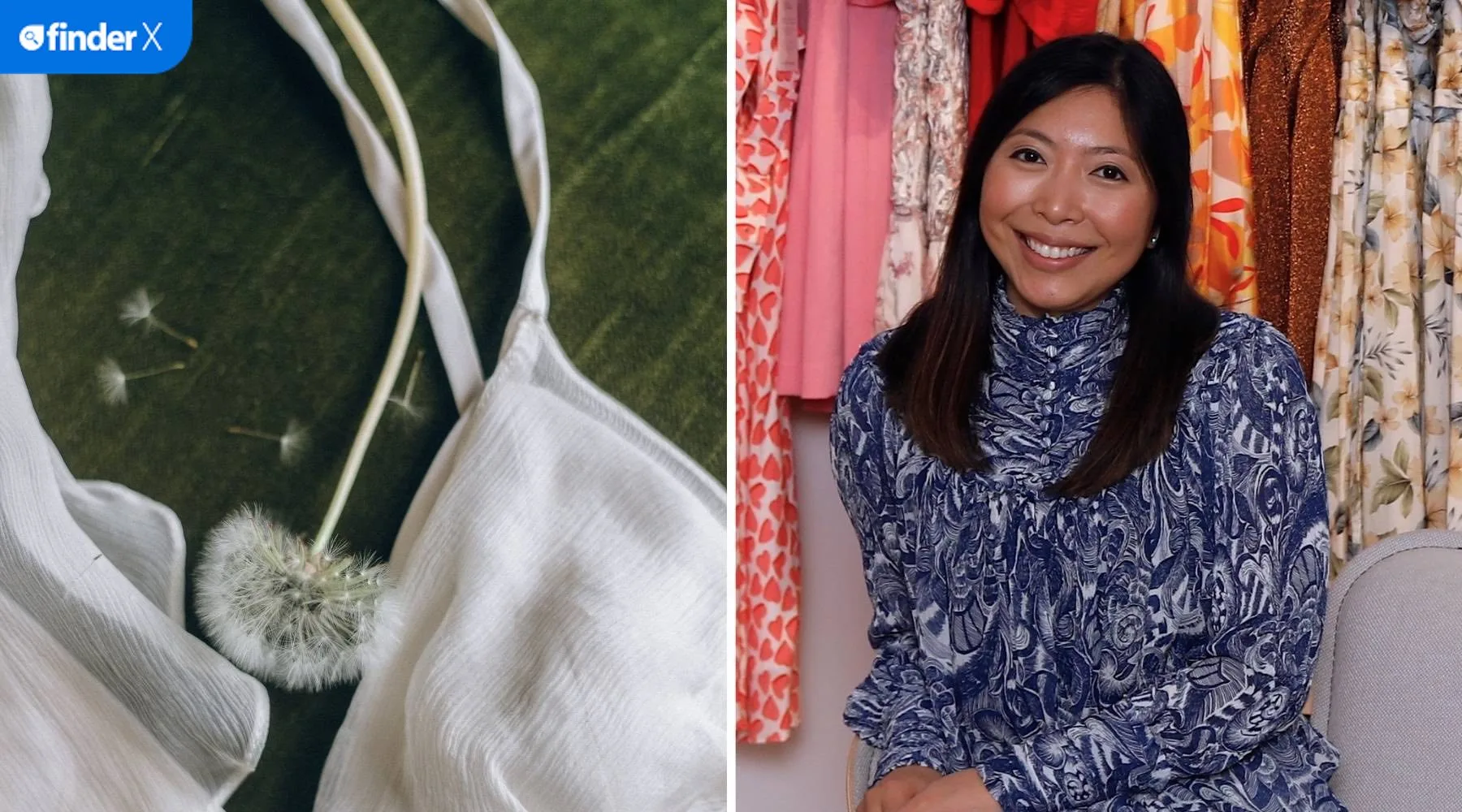What is sustainable fashion?

Fashion entrepreneur Audrey Khaing-Jones breaks down what it means and why it matters for all of us.
The last decade has seen a huge rise in activity around addressing sustainability issues in the fashion industry. But sustainable fashion as a term in itself is often misunderstood.
This is largely because there is no single definition of sustainable fashion. The term is often used as an umbrella term to describe ethical fashion (working conditions), eco fashion (minimising the impact on the environment), slow fashion (buying less, but higher quality garments) and circular fashion (keeping clothing in use).
If you look at the word "sustainable" in the dictionary, it means to sustain something over time. So, while it is fine to say something is "sustainable", you have to explain in what way it's sustainable and what aspects of it relate to that term.
So for example, in the context of GlamCorner (the rental fashion business I co-founded), we look at a garment's sustainability in its entirety, across the supply chain.
We've been able to look at the full garment lifecycle in quite granular detail through the rental model. Longevity is a really important part of the rental fashion business, and we've found that certain fibre types, such as cotton or polyester, can significantly influence the durability and length of time a garment will last.
However, no fibre is perfect. If we look at polyester as one example, it is derived from fossil fuels (a non-renewable resource) and sheds microplastics when laundered. We've made huge investments in our garment cleaning and care process to reduce the shedding of microplastics.
Garment laundering is another area which impacts sustainability. For example, a good household machine uses 13 litres of water per kilo wash. We've been able to reduce our water use down to five to six litres for every kilogram.
The main fashion terms you need to know
While there are concerns around some companies "green-washing" us with exaggerated claims about sustainability, a lot of work has been done to bring a shared understanding to sustainability terms.
In regards to fashion, there is The Sustainable Fashion Glossary – a collaboration between Condè Nast and the Centre for Sustainable Fashion that lists a compendium of key terms, including:
- Eco-friendly: This refers to the use of environmentally friendly materials, such as organic cotton.
- Recycled: In shopping, this involves converting waste into something usable, such as turning plastic bottles into recycled polyester.
- Biodegradable: Along with "compostable", these terms mean clothing that can naturally break down in the environment, and are usually made from natural fibres such as hemp and cotton.
The circular fashion movement
Another key term you may hear is circular fashion or circular economy. Both of these terms refer to a move away from the traditional, linear business model of take-make-dispose, to a more circular, regenerative business model where clothing is kept in use for longer and recycled at the end of its life.
The result is that materials are kept in a loop or circle (which is where the name comes from).
Initiatives such as Ellen MacArthur Foundation's Make Fashion Circular Initiative is driving industry collaboration and innovation towards creating new circular material and business models. Rental and buying pre-loved garments are key parts of the circular fashion economy. At its core, it's about keeping clothing in use which, in turn, reduces the impact clothing waste has on the environment.
Are there changes in the fashion industry that are helping it become more sustainable?
The Australian fashion industry really punches above its weight globally when it comes to blending high quality design with sustainability. Many brands and labels work quietly behind the scenes for many years to create innovative textiles, designs or ways of manufacturing that are better for people and the planet.
Australian consumers are also wanting to know more about how their clothing is made, and initiatives such as Fashion Revolution and Baptist World Aid's Ethical Fashion Report are helping brands bring more transparency to fashion's supply chains.
The Australian fashion community is also very collaborative, and conferences and associations such as Legacy Responsible Fashion Summit, Australian Circular Textiles Association and Good is the New Cool (just to name a few), have been instrumental in bringing people together to take charge and solve sustainability issues together.
The Australian fashion and charity industries have also come together to tackle the significant problem of unwanted clothing in landfill through the Moving the Needle initiative. This gives consumers an easy way to recycle their clothes, with a searchable map of donation points. It is a huge collaboration, with partners including Red Cross, the Salvation Army, GlamCorner, Myer and the National Retail Association. The goal is to reduce textile waste in landfill by 20% by 2022.
What are some options we can look for when we're trying to make greener choices?
Wearing and buying clothing is an essential part of our life. After all, we need to get up and get dressed each day. And the good news is that looking for greener clothing doesn't mean you now have fewer options to choose from or that you're limited to more expensive labels.
On the contrary, there are many ways to make more sustainable choices. Here are a few simple steps you can take:
- Think about where things come from. You can research brands through the Good On You app which rates thousands of brands on their sustainability impact. Or, ask brands directly, search online or even check if any of your friends have some good recommendations.
- Use the "30 wear test". A good rule of thumb is to invest in high quality staple pieces that wash well. To help find these items, ask yourself: "Will I wear this at least 30 times? Do I own something similar? Will this last at least 30 washes?"
- Check the cost-per-wear. While investment pieces may be more expensive, You can calculate the cost per wear by working out how many times you're going to wear this piece, divided by the price. For example, if you buy an $800 dress for a one-off event and only wear it once, then its cost per wear is $800. But if you are purchasing wardrobe staples that you will wear 2-3 times per week, then the cost per wear could be as low as the price of a cup of coffee.
- Shop secondhand. The sustainability benefits of buying secondhand clothing are in extending the lifespan of garments that already exist. WRAP, a UK-based charity tackling the problem of waste across many industries, estimates that if individuals extend the life of their clothing by nine months it would reduce water, carbon and waste by 20-30%.
- Rent clothes. Clothing rental is another option to refresh your look or update your fashion rotation without worrying if you'll wear something 30 or more times. There are a growing number of clothing rental options that suit all kinds of experiences. For example, GlamCorner offers designer outfits that range from power suits to playsuits and maternity wear.
- Ask "what happens next?" Before buying a garment, think about where it will go when you're finished wearing it. For example, choosing a garment that uses 100% of a certain fibre type is easier to reuse or recycle at the end of its life. You can also resell high-quality labels that are no longer in your clothing rotation through eBay or Facebook buy/swap/sell groups. Or donate them to op-shops, charities or return programs set up by other organisations and brands.
Overall, the more we can keep our clothing in use and out of landfill, the more we reduce our impact over time. So, while sustainability is complex and requires looking at multiple factors at different points across a garment's life, these steps are simple ways we can make a difference.
As told to Amy Bradney-George.
Keen to shop more sustainably? Check out Finder's pick of ethical fashion retailers. If you're looking for more ways to make sustainable choices, Finder Green has options for your money, energy, travel shopping and more.
Audrey Khaing-Jones is the co-founder of certified B-Corp and rental platform GlamCorner, Australia's largest online designer fashion rental business. In 2012, Audrey and her husband Dean set out on a mission to revolutionise the way Australian women think about their wardrobes by harnessing the power of the sharing economy and provide a platform that allowed their customers to borrow clothing on-demand and simply return it after use. The company they built now employs over 100 people and processes tonnes of shared clothing per month.
Disclaimer: The views and opinions expressed in this article (which may be subject to change without notice) are solely those of the author and do not necessarily reflect those of Finder and its employees. The information contained in this article is not intended to be and does not constitute financial advice, investment advice, trading advice or any other advice or recommendation of any sort. Neither the author nor Finder have taken into account your personal circumstances. You should seek professional advice before making any further decisions based on this information.
Read more Finder X columns
-
Fit and frugal: 15 million Australians have a New Year’s Resolution for 2026
23 Dec 2025 |
-
3 easy things to do to get your superannuation sorted for the new year
22 Dec 2025 |
-
5 things to consider if you’re switching your CFD broker in 2026
22 Dec 2025 |
-
Boxing Day mania: Aussies set to spend $3.1 billion on sales
22 Dec 2025 |
-
Sleighing the budget: Australians plan to splurge $37 billion this festive season
19 Dec 2025 |
Pictures: Pexels (Nataliya Vaitkevich), Supplied (GlamCorner)
Ask a question
